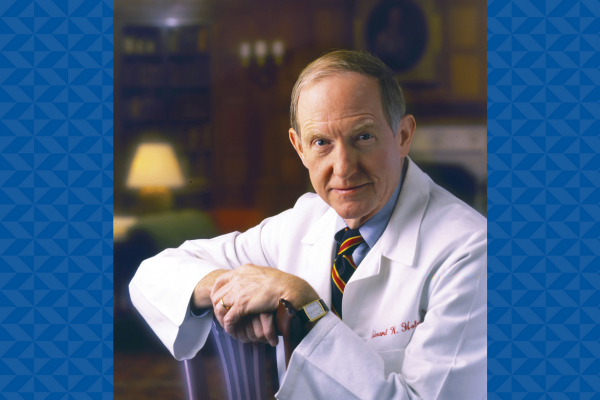
Hitting on All Cylinders
Edward W. Holmes, MD, HS’70-’71, HS’73-’74, served as vice chancellor for academic affairs and dean of the School of Medicine from 1999-2000. Prior to that, he was a Howard Hughes Medical Institute Investigator, James Wyngaarden Professor of Medicine, and chief of the Division of Metabolism, Endocrinology, and Genetics. He is CEO and president of the Sanford Consortium for Regenerative Medicine, vice chancellor and dean emeritus of University of California San Diego Health Sciences, and Distinguished Professor at the University of California.
What were your main priorities when you were dean?
My main priorities centered on ways to make 1 + 1 + 1 — the clinical, research, and educational programs — be greater than three. Collaboration intrigued me the most, and I wanted to build deeper, more effective collaborations across not only the health system but also across the rest of campus. I thought that developing programs that encouraged and supported all of us working together would be more productive than any one of us working alone. This led to forming the Institute for Genome Sciences and Policy (IGSP).
What were your biggest challenges? What was most fulfilling?
My biggest challenge was also my greatest fulfillment. When I arrived in the late 1990s, the Human Genome Project was just coming to fruition. Shortly after that, the sequence of the human genome was announced, and I think everybody recognized this was going to lead to a revolution in health care, education, and the way we did research. When I arrived at Duke, Chancellor Ralph Snyderman had already laid out the vision for IGSP and begun work on putting this program together. I decided to concentrate my effort on this project and help Duke to become a leader in genome sciences.
Provost Peter Lange was supportive of the health sciences and the rest of campus working together. With the help of hands-on people like Joe Nevins, Lange, and Elizabeth Kiss in the social sciences programs, and the guidance of Ralph, we put together a trans-campus institute, which became the IGSP.
We wanted to bring together basic sciences and clinical research. We knew educational programs would have to adapt to this new program, and there would also be many policy issues related to sequencing someone’s genome. The addition of social sciences into IGSP allowed us to address policy and social science. In turn, there were a number of conferences that brought together people from across campus and beyond that shaped our thinking on what IGSP might be. The outcome of all these discussions was the IGSP.
What distinguishes Duke from its peer institutions?
Duke University School of Medicine has excelled in bringing together the three components of the tripartite mission, which are the clinical, research, and education missions. Duke was a trailblazer in launching a novel curriculum. It has always been one of the leading clinical research centers in the world. The health sciences and main campus have an outstanding reputation in the basic sciences. Many institutions excel in one or two areas. Few excel in all three objectives of the tripartite mission.
At the core of this success is people. Duke has been very good at recruiting and retaining outstanding people.
What will be the keys to continuing to succeed in science and health care?
New technology seems to come with each decade and reshapes the way we do things. The institutions that thrive in the future will be ones that embrace new technologies and integrate them in an effective way. The institutions that succeed will be those that are open-minded and willing to train and recruit the new people needed to embrace and adopt these new opportunities.
Story originally published in DukeMed Alumni News, Spring 2024.
Read more from DukeMed Alumni News